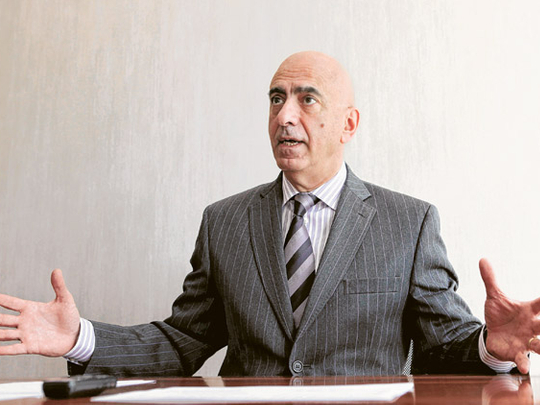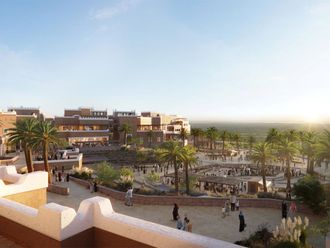
Dubai: Barring the current geo-political turmoil in the Middle East that has marred the hotel sector's performance in some key markets, the region is coming out of the global economic recession extremely well and continues to take a global lead in revenue per available room (RevPAR) — an industry measure for financial performance. And with Dubai leading the way, some of the markets in the region are already beginning to approach their 2007 levels of profitability.
Alex Kyriakidis, Global Managing Director of Tourism, Hospitality and Leisure at Deloitte & Touche (Middle East), talks to Gulf News in an exclusive interview and shares the recipe for future growth for the region's hotels. Excerpts:
Gulf News: How soon do you expect the UAE and overall Middle East hotels industry to bounce back to 2007 levels?
Alex Kyriakidis: The comparison to 2007 is no longer valid for a market like Dubai because structurally the market has changed. We have gone from 30,000 rooms to 50,000 rooms and we have shifted from being largely dependent on the upper upscale and luxury segment to a much diversified segment. Therefore, you'd expect your rate to be lower because you are selling more products at the mid and lower market levels.
I don't think it's valid to say if we will go back to the same hotel rates as we were enjoying in 2007.
What does it mean from the profitability perspective?
Looking at it from the profitability standpoint, for quite a few markets in the Middle East, we are already at the point where we are beginning to approach 2007 levels of profitability for the segment in question.
Some of the best performing markets in the region currently include Dubai, which is steaming ahead. Saudi Arabia is an extremely strong market too. And Muscat is outperforming as well. These markets are getting closer to the 2007 levels of profitability.
Will we see any hotel projects being cancelled or delayed this year in the region?
The remaining hotel pipelines in the GCC markets have cleaned themselves out in the sense that when the economic crisis started, Dubai had 30,000 rooms under development. While one-third of that was completely cancelled due to lack of credit, one-third are well under way to completion and one-third are on the drawing board and will get activated — as they are potentially good projects — once the credit tap starts opening again.
So if you take the view that 50 per cent of those projects that have been parked may happen, then it means that the pipeline for Dubai today is 15,000 rooms to come, until 2015.
How has the region's hotels fared overall in terms of revenue?
The Middle East as a whole is coming out of the global economic recession extremely well and it continues to be a global leader as a region in RevPAR.
The occupancy rates across the region in the first quarter of this year rested at 65 per cent at an average room rate of $220.
That means that the RevPAR for the Middle East is $140. Compare this to the Asia Pacific market, where the RevPAR rests at $90 followed by Europe at $70 and America at $50. So the Middle East is roughly 100 per cent higher than everybody else.
Because of our carriers in the GCC, and specifically in Dubai [Emirates] and Abu Dhabi [Etihad Airways], the growth in our revenue passenger kilometre (RPK), which is the measure the airlines use in the industry, stands at nearly 18 per cent in 2010 as compared with the eight per cent global average. So we are almost again twice the rate of RPK growth of the rest of the world put together.
What this means is that we have two things at play — growth in passenger numbers and increased demand for our hotels, particularly in Dubai.
In this, where does Dubai figure in terms of performance?
Dubai has really come back extremely strongly. The emirate in the first quarter of this year delivered 80 per cent occupancy at an average rate, staggeringly, of $250.
This means that the RevPAR for Dubai is $200, which makes Dubai the number one performer in the region.
It's also interesting to note that Dubai has gone through a dramatic change. Five years ago, the number of operating hotel rooms in Dubai stood at 30,000, of which 90 per cent were in the upper upscale and the luxury segment of the market.
Today, Dubai has 50,000 hotel rooms. But now, 60 per cent of those rooms are upper upscale luxury and 40 per cent are upscale to budget.
So it has been able to absorb as a market all of the new rooms and still deliver 80 per cent plus occupancy, which means that Dubai is beginning to offer the visitors a much broader offering in terms of prices.
How do you see the growth in emerging markets impacting the growth of UAE and GCC hotels?
One of the factors on the world stage that is beginning to impact the Middle East, the GCC and the UAE, is the emerging market. The share of emerging markets in world travel and tourism will double in size and grow from the current seven per cent to 14 per cent over the next 10 years.
The UAE and the GCC stand in a very good position to benefit from that. We predict that if you take China and India — just these two emerging markets will go from about 40 million outbound travellers to around a hundred million outbound travellers between them over the next 10 years.
What would be hurdles to growth?
There are a few clouds on the horizon. The first is the geo-political unrest going on currently in the Middle East, particularly in Egypt, Tunisia, Lebanon, Morocco and Bahrain. Now, Tunisia, Egypt and Morocco are countries that are heavily dependent on tourism for their economies. And clearly they are suffering right now.












